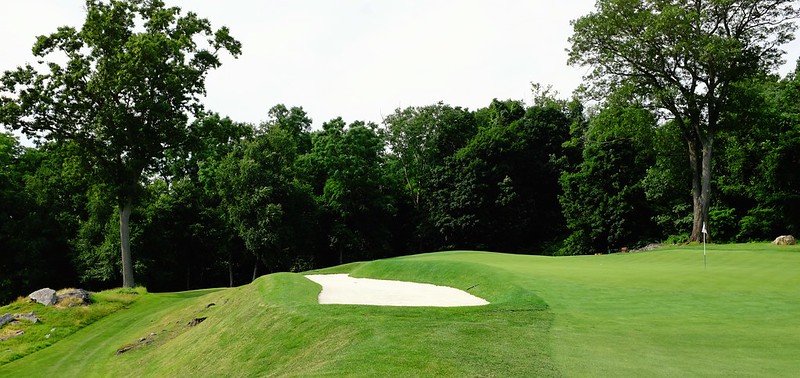Sleepy Hollow Country ClubScarborough-on-Hudson, NY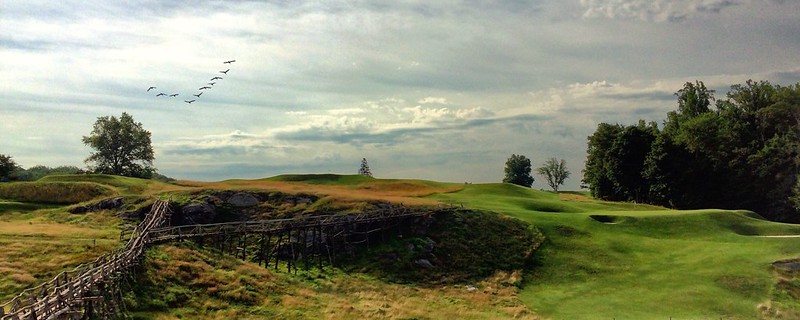
Full disclosure: I love this place. Sleepy Hollow is, quite simply, one of my favorite places in the country to play golf. Exceptional golden age architecture, spectacular views, exciting shots, fabulous conditions -- Sleepy Hollow has everything a golfer could want. And to top it off, Sleepy Hollow is the course that sparked my interest in the work Charles Blair McDonald and Seth Raynor, and subsequently my love for golf architecture generally. So I'm biased.
The 15th and 16th Greens
And of course, I've been wanting to do a photo tour of Sleepy Hollow for quite some time. As with my tour of Old Town Club, Sleepy Hollow's recent near miss on Golf Digest's Top-100 list provided a perfect impetus and incentive to pull this tour together and shine a bit of a light on a place that, for me, is ranked about 100 spots too low.
The "lesser" of the Par-3s at Sleepy Hollow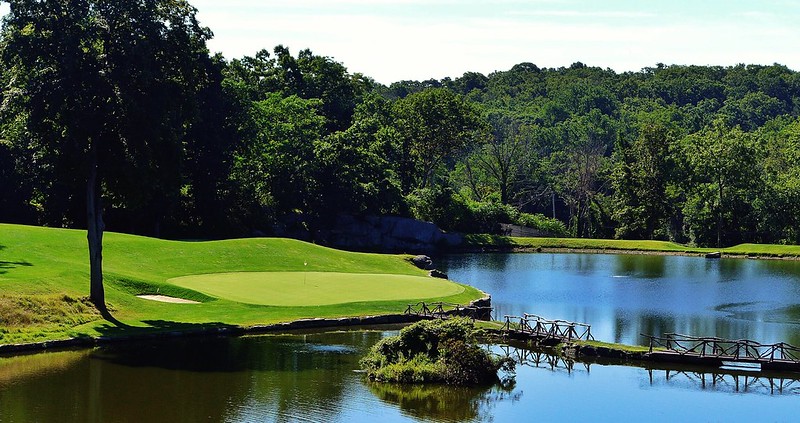
For those unfamiliar with Sleepy Hollow, Ran has a wonderful profile you should read here:
http://golfclubatlas.com/courses-by-country/usa/sleepy-hollow-country-club-ny-usa/. However, that profile is now nearly eight years old, and there have been changes made to the course, including additional tree removal (another impetus for this tour). The photographs you see below were taken over the course of two recent visits to Sleepy Hollow (which is the reason for the differences in light, course conditions and pin positions).
Waking Up at Sleepy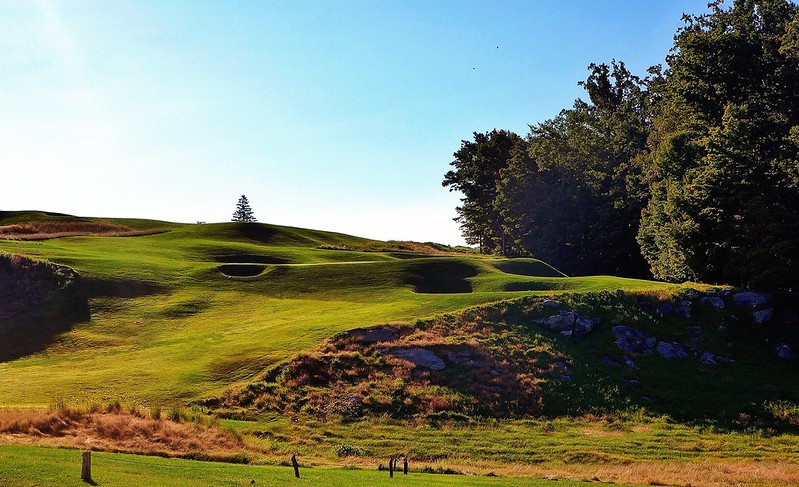
I hope you enjoy the tour.
Sleepy Hollow Country ClubSleepy Hollow was built on the 338-acre Woodlea estate, which the club acquired in 1911. C.B. Macdonald designed the golf course, with Seth Raynor on the ground as engineer, and the original 18 holes were completed that same year. In the late 1920s, AW Tillinghast expanded the course to 27 holes, creating several new holes for the 18-hole "Upper" and 9-hole "Lower" courses. Via the passage of time and the intrusion of several interim architects of more modern vintage, the course lost touch with its golden age roots for a period, but as we here at GCA know, George Bahto and Gil Hanse were brought in to restore the course's rightful Macdonald heritage.
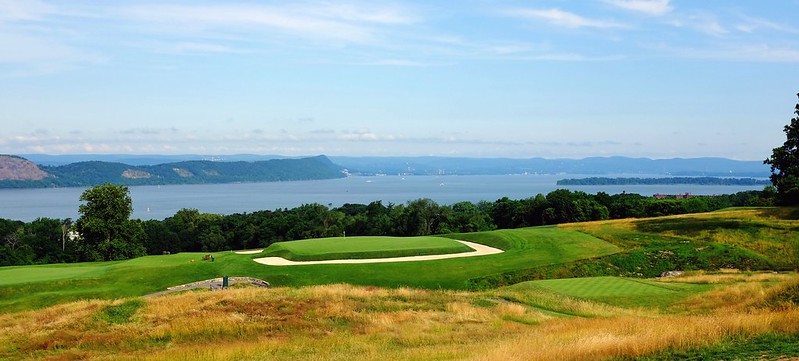
The result speaks for itself. In its present form, the main course at Sleepy Hollow is rife with beautiful interpretations of many of the Macdonald templates, including Redan, Punchbowl, Double Plateau, and one of the most gorgeous Shorts this side of Fishers Island. While the property has been owned by Colonel Eliot Shepard and William Rockefeller, and the course has been worked on by some of the great architects in golf, including Tillinghast and Hanse, Sleepy Hollow today stands clearly as a shining example of CB Macdonald's design tenets and as a fitting monument to George Bahto. Quite a lineage.
The Clubhouse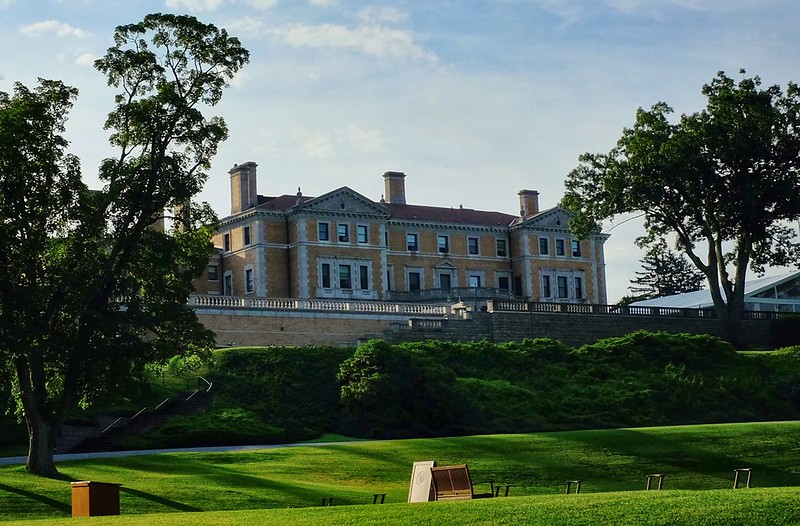
No tour of Sleepy Hollow is complete without at least a brief discussion of its magnificent clubhouse. Some of the best courses in the country are identifiable by their clubhouses alone, and in a few instances -- Winged Foot, Oakmont, Myopia Hunt, Ridgewood, and Shinnecock, to name but a few -- they become iconic in their own right. Sleepy Hollow's is one such clubhouse.

Looming high above, the clubhouse, designed by Stanford White in 1893 as the manor house, is the first thing the golfer notices about Sleepy Hollow upon entering the gates, and it provides quite the first impression. As the long entrance road makes way up toward the building, the loping route provides views of several holes on the lower course, the driving range, the stables, and the many rock formations that remind the golfer that he's in Westchester. But all the while, the presence of the massive clubhouse dominates.
The entrance road culminates at the south face of the clubhouse, seen in the photo below. The parking lot is in the rear, to the right.
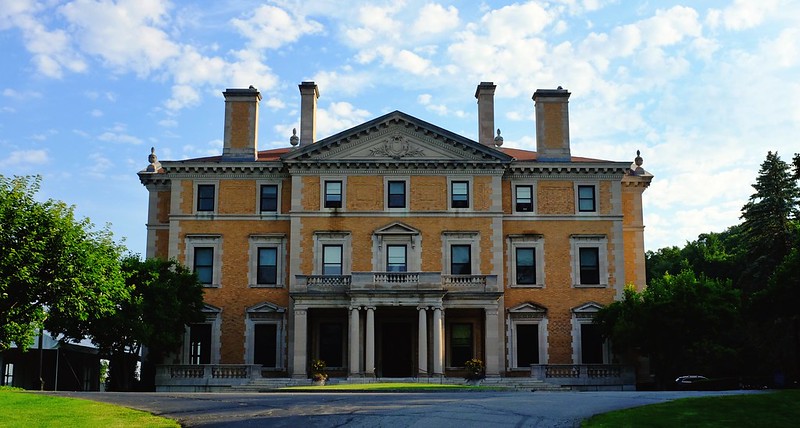
The clubhouse has been the scene of several television shows and movies, and has hosted countless events. And with views like this from its spacious lawn, it's easy to see why.

It is a beautiful building and a fitting way to begin a day at Sleepy Hollow.
The Scorecard, Logo and Haunted BridgesA golfer senses a theme at Sleepy Hollow. The club has named its each of its holes in reference to Washington Irving's story, which was set in the surrounding hills. The course itself stretches to 6880 yards and plays quite plesantly at 6377 yards from the white tees (which I use for this tour) to a par of 70.
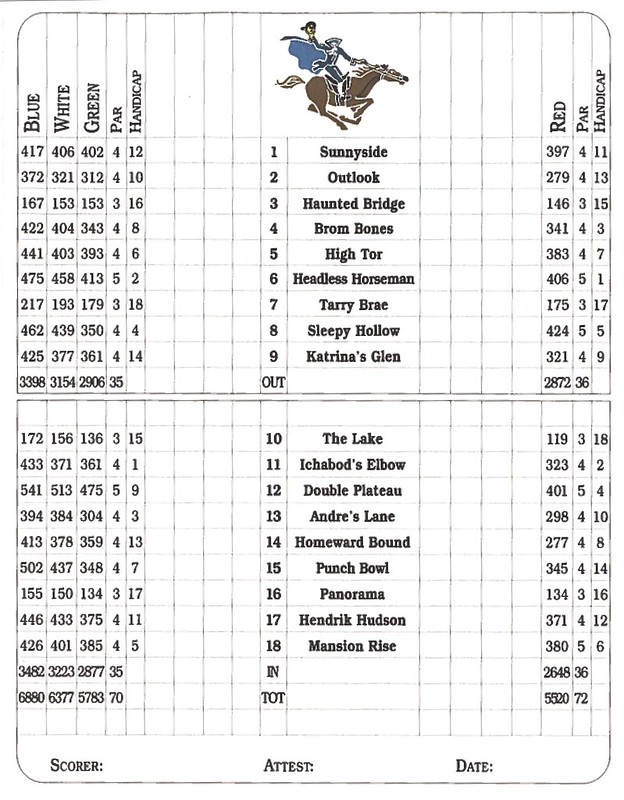
The club's logo of the Headless Horseman, likewise taken from the Irving story, is one of the best in golf.

Finally, the Haunted Bridges, encountered on the 3rd, 10th and 16th holes, appear to have been built by Irving's contemporaries and provide a unique and fitting touch.
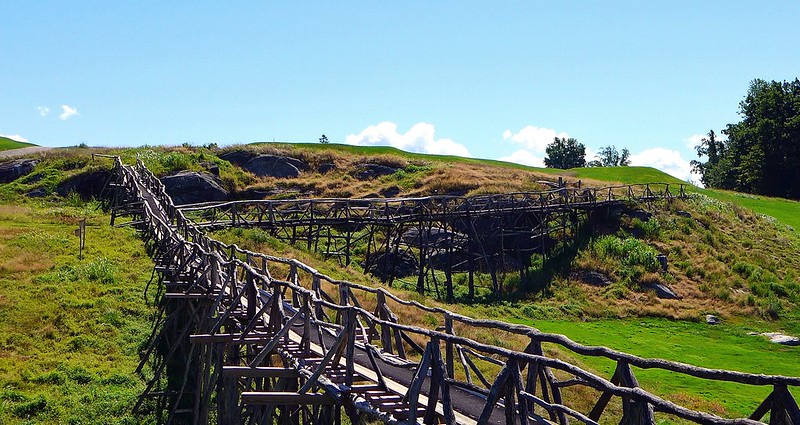 The Golf Course at Sleepy Hollow Hole 1 - "Sunnyside" - 406yds - Par 4
The Golf Course at Sleepy Hollow Hole 1 - "Sunnyside" - 406yds - Par 4There is no more enjoyable way to start a round of golf that from a first tee that sits in the shadow of the clubhouse, as is the case at Sleepy Hollow. The Hudson river just peeks out above the treeline, giving the golfer a small taste of what's to come.
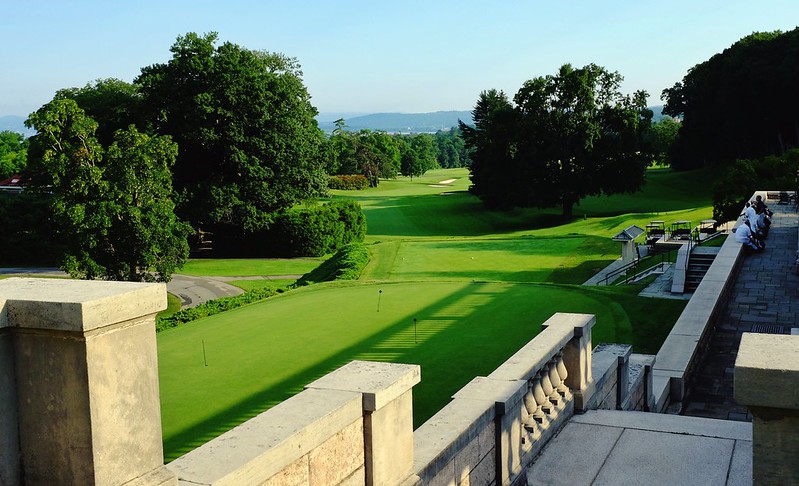
The first hole is a downhill dogleg right which, while tree lined, has a more generous landing area and more room to work the ball than it first appears. The ideal position is the left half of the fairway.

The first green is of a good size, but the bunkering on both sides and the visually deceptive framing bunker short left make for a challenging first iron.
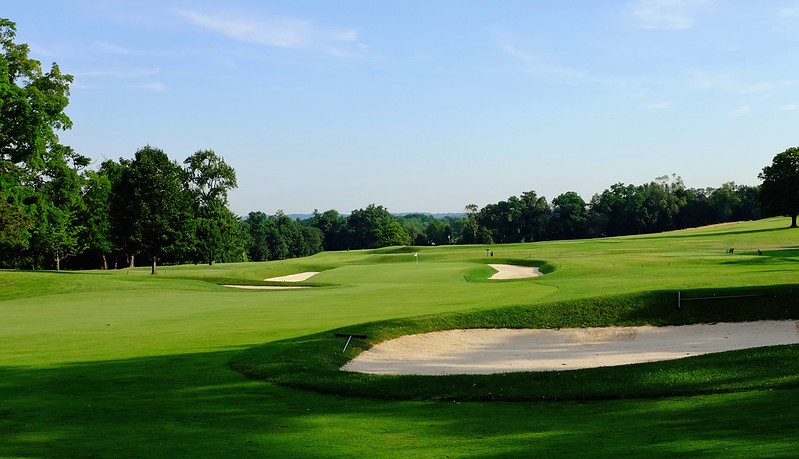
The fairway runs seamlessly into the green, allowing for the ball to be run on to the putting surface, but the green slopes up from front to back. The deep Macdonald bunkering is felt immediately.
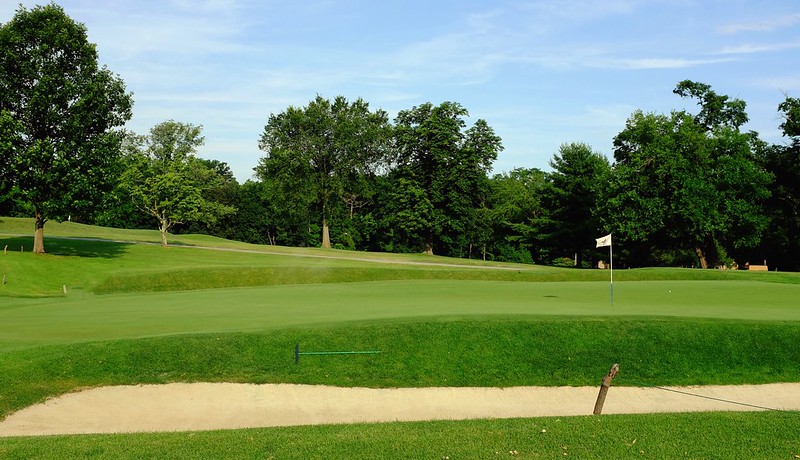
The view back up the first hole -- steeper than it appears, and a solid start to what will become a memorable round.
 Hole 2 - "Outlook" - 321yds - Par 4
Hole 2 - "Outlook" - 321yds - Par 4Reminiscent of the first hole at Myopia, the second hole is a short, uphill par-4 defended by a relatively severe, well-protected green. The "eyeglasses" bunkers short of the fairway are not in play, but make for an appealing visual effect.
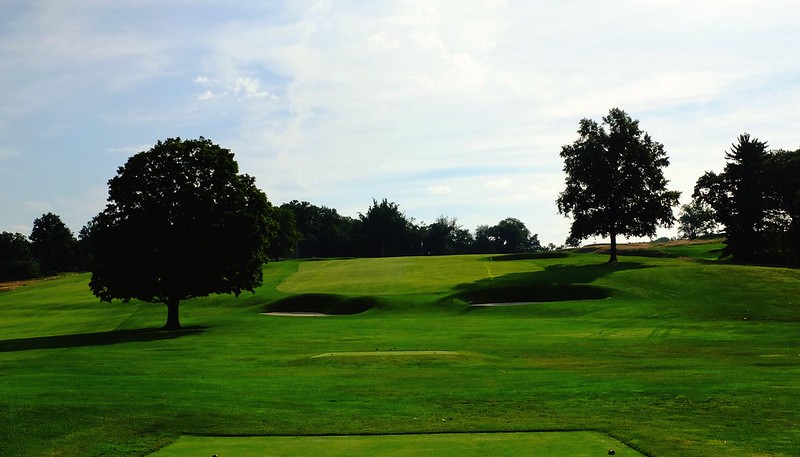
The approach to the second green will almost always be from an uphill lie, making for frequent short-right misses. This deep-and-steep wraparound front-right bunker is waiting to catch those misses.

The climb to the second green at Sleepy Hollow is the first point on the course where the golfer is treated to both the stunning views of the Hudson River . . .
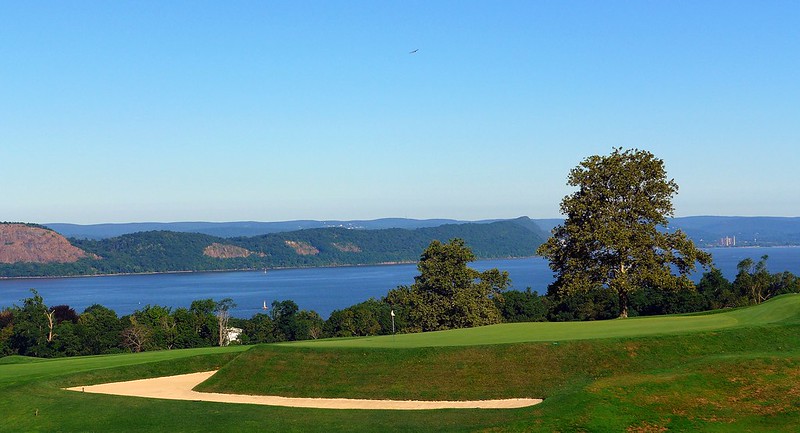
. . . and to the sight of Sleepy Hollow's one-of-a-kind walking bridges. This is the point in the round where the golfer knows, beyond a doubt, that a special day awaits.
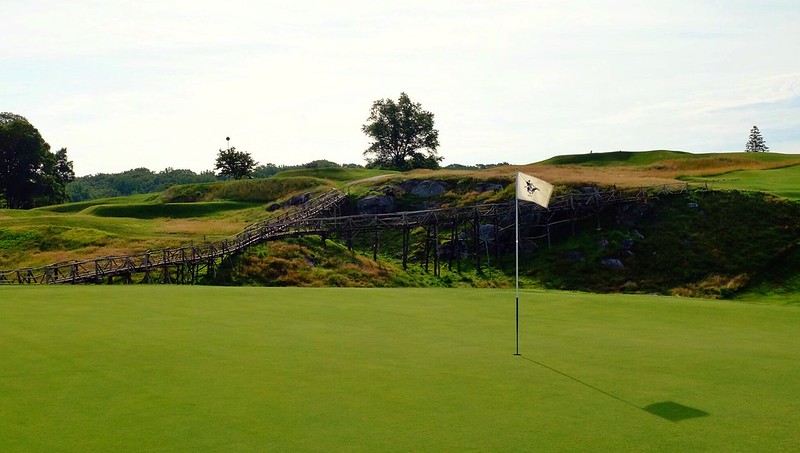 Hole 3 - "Haunted Bridge" - 153yds - Par 3
Hole 3 - "Haunted Bridge" - 153yds - Par 3Aptly named, the third hole may be the best par 3 among the standout collection of one-shotters at Sleepy Hollow. Played over a deep ravine to a green elevated just enough so that the golfer cannot see the entire putting surface, the third provides one of the most exciting tee shots on the front nine at Sleepy Hollow.

The way in which the land was sculpted and the third green was benched into the hill will appeal to even the most jaded GCA enthusiasts.

To access the green, the golfer crosses the Haunted Bridge for the first time. Simply beautiful.
 Hole 4 - "Brom Bones" - 404yds - Par 4
Hole 4 - "Brom Bones" - 404yds - Par 4Cresting the hill after putting out on the third green, the golfer is afforded a wide view from the fourth tee over a large, open section of the golf course. The fourth hole plays out to an open fairway that dips down, then crests a small rise before arriving at the green.

Longer shots may clear the rise, offering the golfer an unobstructed view of the putting surface. For those that do not, an aiming marker is provided behind the green.
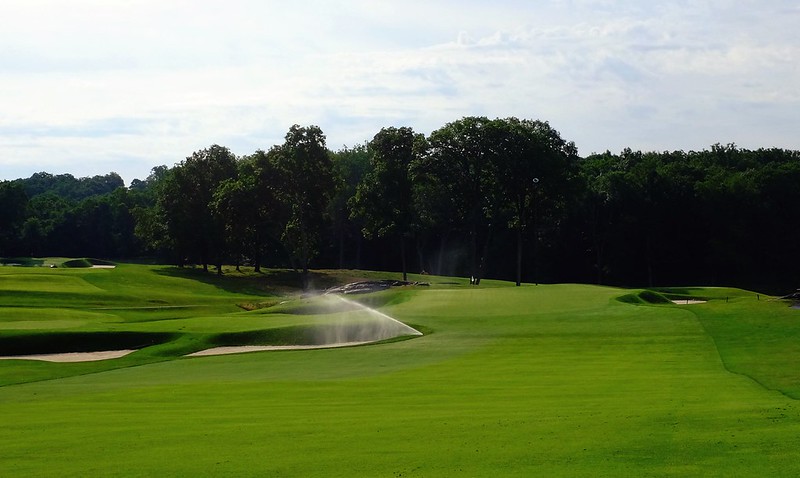
A precision approach shot is required, as the fourth green is well guarded with deep bunkers, and is itself riddled with undulations, allowing for difficult pin positions.
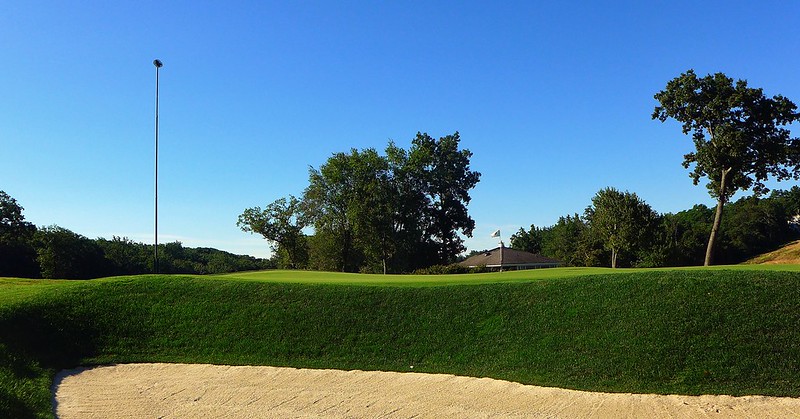 Hole 5 - "High Tor" - 403yds - Par 4
Hole 5 - "High Tor" - 403yds - Par 4Playing back in the direction of the fourth tee, the fifth hole plays over the rise in the fairway (which is easily carryable for all players), then drops quickly before again rising to meet the green. The view from the crest of the rise is spectacular.

The encroaching bunkers, which begin well short of the fourth green, provide for an added challenge on the player's approach. Shots that come up short are in danger of rolling several yards back down the fairway.

Approaches that come up short face this shot, with only the green (with its false front and varying internal mounds) and the pin in view.
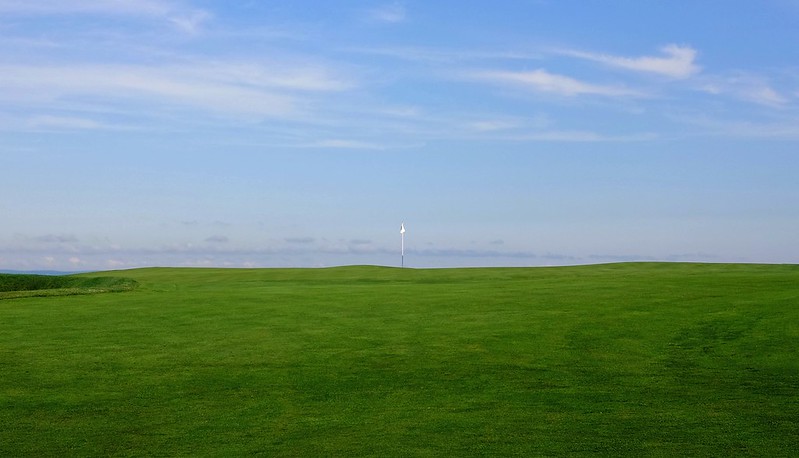
The fifth green. No words necessary.
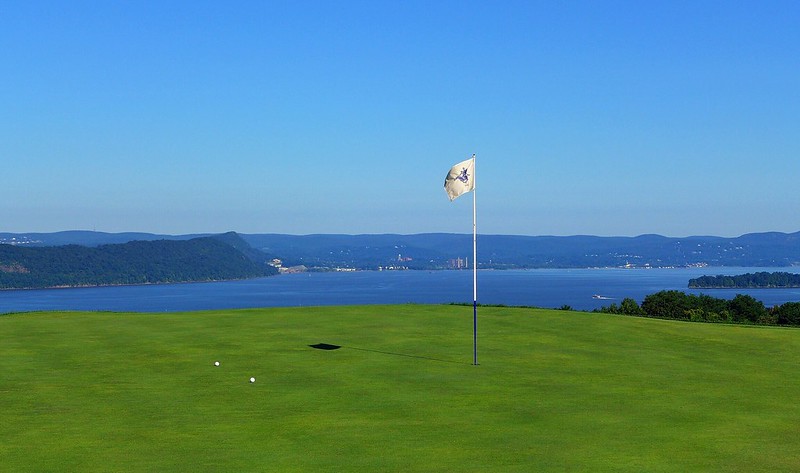 Hole 6 - "Headless Horseman" - 458yds - Par 5
Hole 6 - "Headless Horseman" - 458yds - Par 5The first three shot hole at Sleepy Hollow is short on the card but plays longer, thanks to the hill that must be climbed before reaching the second fairway. Aggressive, longer hitters can carry the steep, mounded wall but many players are better off simply laying up short of it. Right is dead, and the massive grass bunker on the left side of the hill just wishes it was dead.
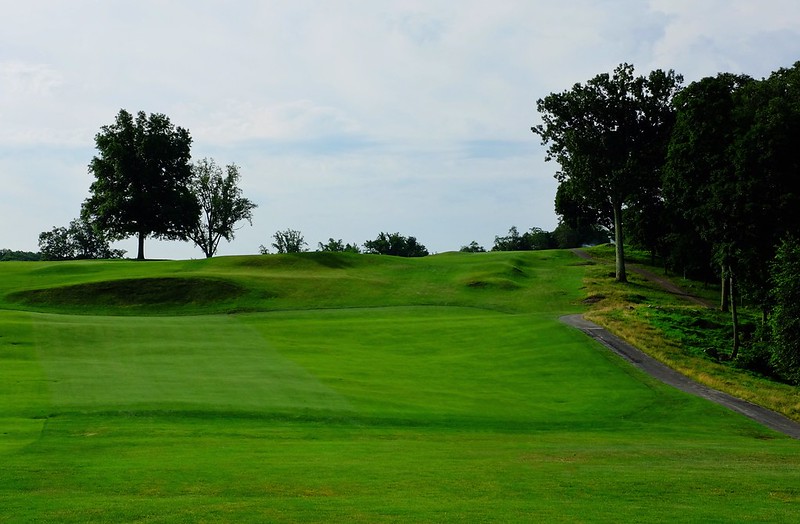
Once reaching the upper tier of fairway, the golfer must contend with the principal's nose bunkering, which sits smack in prime lay-up territory some sixty yards short of the green.

The sixth green slopes substantially from back to front -- approaches that end up beyond the hole will result in a very tricky putt back down to the hole.
 Hole 7 - "Tarry Brae" - 193yds - Par 3
Hole 7 - "Tarry Brae" - 193yds - Par 3In your author's humble opinion, the best downhill reverse-redan hole in existence.
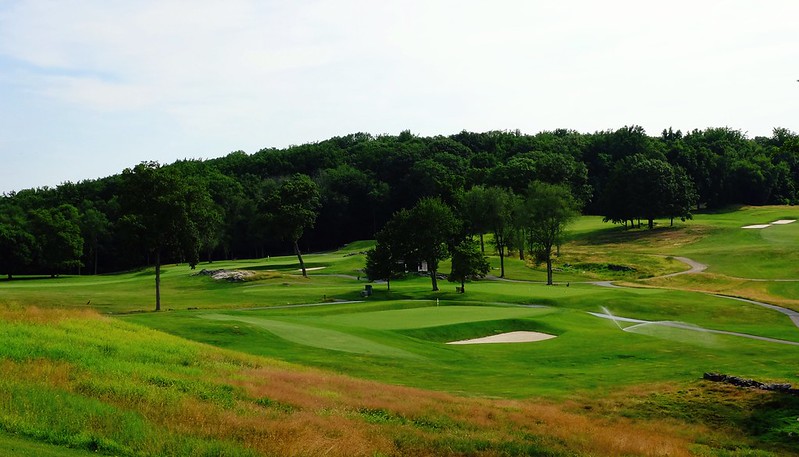
The steepness of the green from high left to low right is so pronounced that balls routinely roll for 30 seconds or more as they funnel down toward the pin. A wonderfully exciting hole to play.
 Hole 8 - "Sleepy Hollow" - 439yds - Par 4
Hole 8 - "Sleepy Hollow" - 439yds - Par 4The eighth hole begins the stretch of holes that were originally laid out by Tillinghast, and which are, for the most part, on a flatter, narrower portion of the property. Nevertheless, the rolling terrain provides for many interesting shots, as first seen on the par-4 eighth hole. Off the tee, the preferred result is the left side, but the partially hidden low left fairway bunker must be avoided. A large mound in the right half of the fairway can scatter balls in any direction.
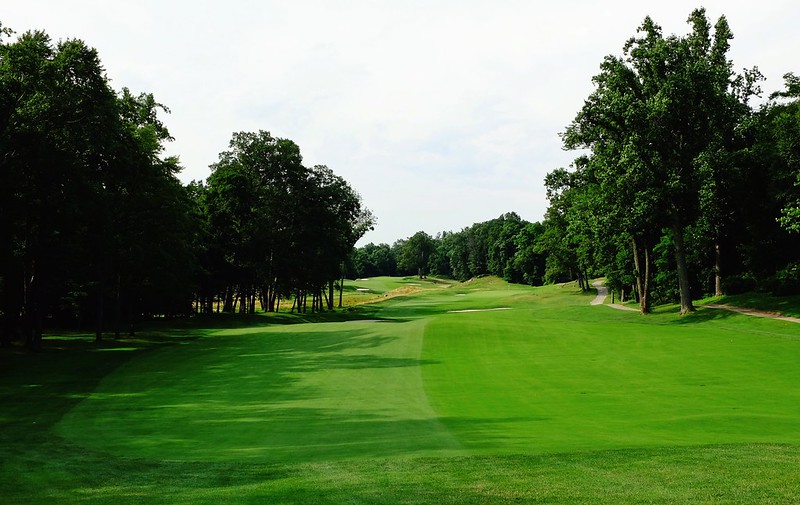
The eighth green is set perfectly among the hills and rocky outcroppings. A false front repels indifferent approaches.

The eighth green, with the eleventh green complex visible behind.
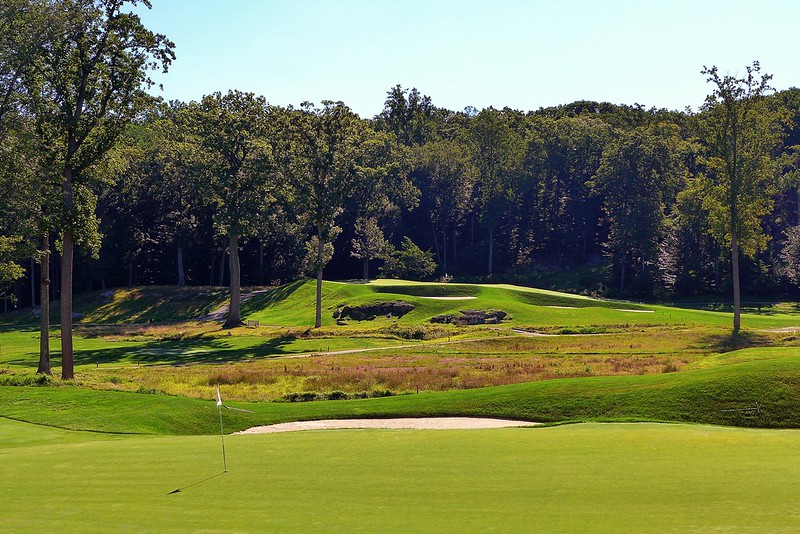 Hole 9 - "Katrina's Glen" - 377yds - Par 4
Hole 9 - "Katrina's Glen" - 377yds - Par 4The ninth provides a generous landing area for tee shots, but balls that end up short and right will face a blind approach to a small, well defended green.
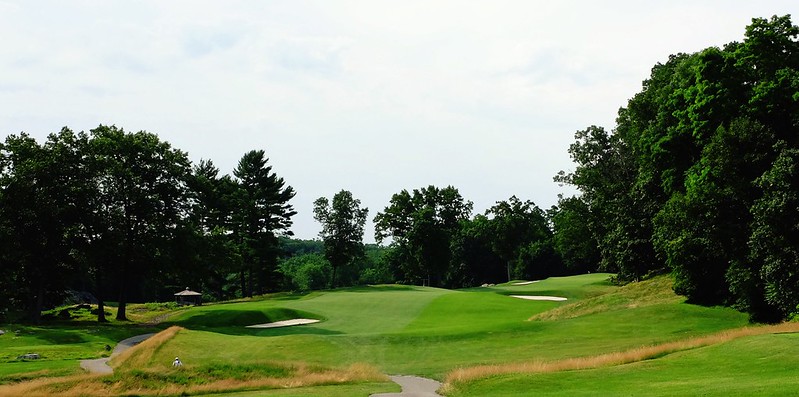
Tee shots that find the high left side of the fairway will have the preferred look down the center of the slightly elevated green.

As shown in this photo, missing left is bad, but missing far left is awful. Note the many appealing pin positions in the rippling green.
